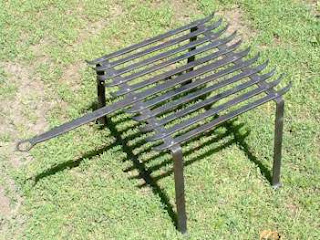Gridiron

Football season is upon us, and Tom from Boyne City, Michigan, asked why the football field is called a gridiron.
In the football sense, it dates back to 1897. The word seems first to have appeared in print in a Boston Herald account of the annual Yale vs. Harvard game. The most likely reason for the analogy is that the lines painted on the field to mark the yardage look like the parallel bars of a griddle, a gridiron.
Long before that use, it was “a cooking utensil formed of parallel bars of iron or other metal in a frame, usually supported on short legs, and used for broiling flesh or fish over a fire.” [OED]
In a gruesome variation, a similar structure was also used as an instrument of torture. The victim would be roasted over a fire. This is why the stylized symbol representing St. Lawrence, the martyr, is a gridiron. [See The Catholic Encyclopedia]
The word gridiron eventually applied to any grate-like structure, such as those found on a dam or a weir, a network of pipes, a scaffolding, a set of planks located above a theatrical stage from which scenery was lowered, and crisscrossing railroad tracks.
For some $5 words representing the idea of a gridiron or network, see craticle, graticule, and reticulated. From Samuel Johnson’s Dictionary:
• “Network: Any thing reticulated or decussated, at equal distances, with interstices between the intersections.”
• “Reticulated: Made of network; formed with interstitial vacuities.”
SIDEBAR: NFL Gridiron Gab
Now available from McFarland & Co.: Word Parts Dictionary, 2nd edition
Listen to Mike’s program in real time every Tuesday morning, 9:00 - 10:00 a.m. EST, by going to wtcmradio.com and clicking on Listen Now. There is no archive.
Write to Mike with comments or questions:
wordmallATaol.com
(substitute @ for AT above)
wordmallATaol.com
(substitute @ for AT above)
Check out Mike's program-based books here:
Arbutus Press
http://arbutuspress.com/store_ling.html
or at Amazon.com
Arbutus Press
http://arbutuspress.com/store_ling.html
or at Amazon.com
Visit the Senior Corner at http://seniors.tcnet.org


Comments